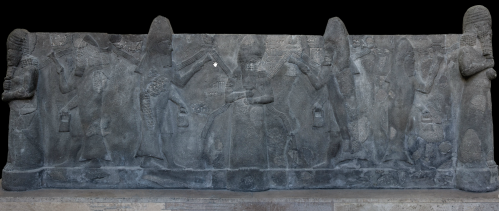Izre’el: The Tale of the Adapa Myth
by Estéban Trujillo de Gutiérrez
“Moreover, there is further textual evidence for the identification of the two figures in the combined name u-an(-na) adapa or u-ma-a-num a-da-pa (Lambert 1962: 73-4; van Dijk 1962: 44-8; Hallo 1963: 176; Bottéro 1969-70: 106; Borger 1974: 186; Picchioni 1981: 97-101; Kvanvig 1988: 202-4; Denning-Bolle 1992: 44-5; cf. Albright 1926).
The mythological figure Adapa has, thus, two variants: one is called Uan; another is called Adapa. The myth of the seven primordial sages shares with the Berossus tradition the mytheme of emergence from water. The etymological equation between Adapa and ù.tu.a.ab.ba is related to a similar tradition, while his having ascended to heaven is perhaps recalled by the name Uan, which includes a direct reference to heaven (An).

Purādu-fish apkallū were antediluvian sages, the famous Seven Sages of Sumeria were purādu-fish.
The genotype is also attested in Berossus, as the form of the mentor of mankind, Oannes.
Thus it was Oannes-Adapa who instructed people about the ordinance of the earth. It is with this theme that the myth of Adapa and the South Wind opens.
The Story
The myth as we know it opens with a description of the background to the main narrative. This background has reached us through what is now called Fragment A, of which the very first line or lines are missing (for the find and the extant fragments, see below).
The first legible lines refer to the power of divine speech, and it is said that Ea—known to us as the Mesopotamian god of fresh water and wisdom—perfected Adapa “with great intelligence, to give instruction about the ordinance of the earth. To him he gave wisdom, he did not give him eternal life” (lines 3’-4’).
Adapa was a servant of Ea. Respected and adored by his community, he performed the chores necessary to the daily rituals, which included, among others, supplying fish from the nearby sea.
One day Adapa’s journey to the wide sea ended unexpectedly in a sudden burst of the South Wind. Adapa was plunged into the sea. Here begins the narrative as we know it from Fragment B. This fragment has some close, albeit broken, parallels in Fragment C and at the beginning of Fragment D.
Adapa, who for the first time in his life had met with some difficulty, could do nothing other than to threaten the blowing wind that he would break its wing. As soon as he uttered this threat, the wing of the South Wind broke.

Click to zoom.
A solid basalt tub recovered from outside the Temple of Ishtar at Nineveh, now in the collection of the Pergamon Museum.
Ea is readily identified at the center with water flowing from his shoulders. Ea is surrounded by apkallu, puradu-fish apkallu.
The puradu-fish apkallu have a fish head and fish skin flowing down their backs. They raise rectangular objects of unknown etiology in their right hands, in their traditional acts of purification and blessing. The banduddu buckets are, as usual, in their lowered left hands.
This tub probably portrays the Seven Sages of antediluvian Sumeria.
Nothing could be done against Adapa’s spell, and Anu, the sky god and the head of the Mesopotamian pantheon, called Adapa to task. The situation was indeed unpleasant for the disciple of Ea. Yet, a god such as Ea would not risk a meeting between his loyal servant and Anu without proper preparation.
As might be appropriate for the god of wisdom, Ea, well known also for his artful character, supplied Adapa with minute instructions that were intended to save his life. Among these were strict orders to avoid any food or drink offered to him in heaven, any of which Ea said would bring death on Adapa.
However the situation turned out to be rather different from what Adapa anticipated. While in heaven, Anu’s anger was appeased by two deities, Dumuzi and Gizzida, who were standing at the gate of heaven. Following Ea’s instructions, Adapa had paid a tribute of flattering words to them. Instead of being offered deadly food and water, he was offered the food and water of life.
Adapa refused it, and thus—at least according to one recension, recorded in Fragment B—lost a unique and irreversible chance for eternal life.
However, according to another version of the story, recorded in Fragment D, Anu seems to have shown Adapa the awesomeness of heaven and to have installed Adapa in his own rather than in Ea’s service. This fragment also adds to the myth a healing incantation that is based on the very fact that Adapa, “a seed of humankind,” succeeded in breaking the wing of the South Wind.”
Schlomo Izre’el, Adapa and the South Wind: Language Has the Power of Life and Death, Eisenbrauns, 2001, pp. 2-5.

[…] Izre’el: The Tale of the Adapa Myth. […]
LikeLike
[…] and 1 Enoch 6–11 to the apkallu tradition, Atrahasis, and the Adapa myth (Roots of Apocalyptic, 270–342, esp. pp. […]
LikeLike